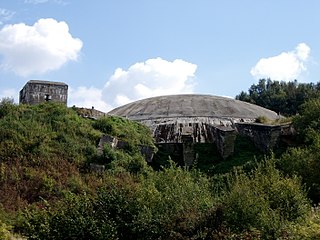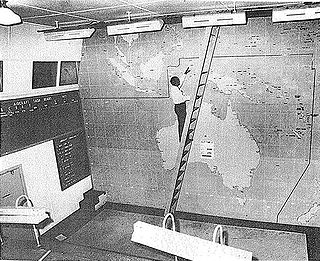
The Dornier Do 217 was a bomber used by the German Luftwaffe during World War II as a more powerful development of the Dornier Do 17, known as the Fliegender Bleistift. Designed in 1937 and 1938 as a heavy bomber but not meant to be capable of the longer-range missions envisioned for the larger Heinkel He 177, the Do 217's design was refined during 1939 and production began in late 1940. It entered service in early 1941 and by the beginning of 1942 was available in significant numbers.

La Coupole, also known as the Coupole d'Helfaut-Wizernes and originally codenamed Bauvorhaben 21 or Schotterwerk Nordwest, is a Second World War bunker complex in the Pas-de-Calais department of northern France, about 5 kilometres (3.1 mi) from Saint-Omer, and some 14.4 kilometers south-southeast from the less developed Blockhaus d'Eperlecques V-2 launch installation in the same area. It was built by the forces of Nazi Germany between 1943 and 1944 to serve as a launch base for V-2 rockets directed against London and southern England, and is the earliest known precursor to modern underground missile silos still in existence.

The Bombing of Darwin, also known as the Battle of Darwin, on 19 February 1942 was the largest single attack ever mounted by a foreign power on Australia. On that day, 242 Japanese aircraft, in two separate raids, attacked the town, ships in Darwin's harbour and the town's two airfields in an attempt to prevent the Allies from using them as bases to contest the invasion of Timor and Java during World War II.

The Aggregat series was a set of ballistic missile designs developed in 1933–1945 by a research program of Nazi Germany's Armed Forces (Wehrmacht). Its greatest success was the A4, more commonly known as the V-2.

The Red Hill Bulk Fuel Storage Facility is a military fuel storage facility in Hawaii. Operated by the United States Navy, Red Hill supports U.S. military operations in the Pacific.

An oil terminal is an industrial facility for the storage of oil, petroleum and petrochemical products, and from which these products are transported to end users or other storage facilities. An oil terminal typically has a variety of above or below ground tankage; facilities for inter-tank transfer; pumping facilities; loading gantries for filling road tankers or barges; ship loading/unloading equipment at marine terminals; and pipeline connections.

The Exolum Pipeline System, formerly the CLH Pipeline System and the Government Pipelines and Storage System (GPSS), is a fuel pipeline system in the United Kingdom. Originally constructed by the government to supply fuel to airfields in World War II, it is now owned by Exolum.

RAAF Base Tindal is a Royal Australian Air Force (RAAF) military air base and civil aviation airfield located 8 nautical miles east southeast of the town of Katherine, Northern Territory in Australia. The base is currently home to No. 75 Squadron and a number of non-flying units, and also hosts the civilian Katherine Tindal Airport. First constructed in 1942, it was refurbished in the late 1960s as a bare base capable of being utilised when required. It was opened as a permanently manned RAAF base in 1989.

Grissom Air Reserve Base is a United States Air Force base, located about 12 miles (19 km) north of Kokomo in Cass and Miami counties in Indiana. The facility was established as a U.S. Navy installation, Naval Air Station Bunker Hill, in 1942 and was an active Air Force installation, Bunker Hill Air Force Base from 1954 to 1968, and Grissom Air Force Base from 1968 to 1994. Pursuant to a BRAC 1991 decision, the installation was downsized to an Air Force Reserve installation and renamed Grissom Air Reserve Base.

Stalingrad, a Soviet city and industrial centre on the river Volga, was bombed heavily by the Luftwaffe during the Battle of Stalingrad in World War II. German land forces comprising the 6th Army had advanced to the suburbs of Stalingrad by August 1942. The city was firebombed with 1,000 tons of high explosives and incendiaries in 1,600 sorties on 23 August. The destruction was monumental and complete, turning Stalingrad into a sea of fire and killing thousands of civilians and soldiers. Further fire-attacks were mounted against the ruined city for the next two days, enveloping it in dense volcano-like black smoke clouds that stretched 3.5 kilometers into the sky. At least 90% of the housing stock was obliterated.
The Focke-Wulf Ta 400 was a large six-engined heavy bomber design developed in Nazi Germany in 1943 by Focke-Wulf as a serious contender for the Amerikabomber project. One of the first aircraft to be developed from components from multiple countries, it was also one of the most advanced Focke-Wulf designs of World War II, though it never progressed beyond a wind tunnel model.

The Valentin submarine factory is a protective shelter on the Weser River at the Bremen suburb of Rekum, built to protect German U-boats during World War II. The factory was under construction from 1943 to March 1945 using forced labour, but was damaged by air-raids and unfinished by the end of the war. The Valentin factory was the largest fortified U-boat facility in Germany, and was second only to those built at Brest in France.

Bankstown Bunker, formerly known as Air Defence Headquarters Sydney, is a heritage-listed defunct Royal Australian Air Force (RAAF) operations facility, located on the corner of Marion and Edgar Street, in Condell Park, New South Wales, Australia. It was designed by the Allied Works Council and built from 1943 to 1944 by Stuart Bros Pty Ltd of Sydney. It is also known as Air Defence Headquarters Ruin Sydney (former), No. 1 Fighter Section Headquarters, 1FSHQ, Bankstown Bunker and RAAF No. 1 Installation Bankstown; No. 101 Fighter Sector. It was added to the New South Wales State Heritage Register on 18 November 2011.

Hohlgangsanlage are a number of tunnels constructed in Jersey by occupying German forces during the occupation of Jersey. The Germans intended these bunkers to protect troops and equipment from aerial bombing and to act as fortifications in their own right.

The Glenbrook Tunnel is a heritage-listed single-track former railway tunnel and mustard gas storage facility and previously a mushroom farm located on the former Main Western Line at the Great Western Highway, Glenbrook, in the City of Blue Mountains local government area of New South Wales, Australia. The Department of Railways designed the tunnel and built it from 1891 to 1892. It is also known as Lapstone Hill tunnel and Former Glenbrook Railway and World War II Mustard Gas Storage Tunnel. The property is owned by Blue Mountains City Council and Land and Property Management Authority, an agency of the Government of New South Wales. It was added to the New South Wales State Heritage Register on 5 August 2011. The railway tunnel was originally part of the Glenbrook 1892 single-track deviation, which bypassed the Lapstone Zig Zag across the Blue Mountains. It is 634 metres; 693 yards long and is constructed in an 'S' shape with a gradient of 1:33.

Charlie's Hill Radar Station is a heritage-listed radar station off Charlie's Hill Road, Inkerman, Shire of Burdekin, Queensland, Australia. It was built in 1943 by Royal Australian Air Force. It was added to the Queensland Heritage Register on 23 February 2001.

WWII RAN Fuel Installation is a heritage-listed former fuel depot and now arts centre at Collins Avenue, Edge Hill, Cairns, Cairns Region, Queensland, Australia. It was built in 1943. It was added to the Queensland Heritage Register on 2 February 2007.

Vestey's Meatworks, officially the North Australia Meat Company, was a slaughterhouse in Darwin, Northern Territory, Australia, built by Vestey Brothers between 1914 and 1917. Never profitable, it operated for three years before the company abandoned the venture in the aftermath of the Darwin rebellion. Most of the facility was demolished in 1957, but two large water tanks remain standing today, on what is now the site of the Darwin High School on Bullocky Point in the suburb of The Gardens. The beach to the north of Bullocky Point is called Vestey's beach as a result of the meatworks.
Cootamundra World War II Fuel Depot is a heritage-listed former fuel depot and Royal Australian Air Force (RAAF) stores depot and now public park at 219 Sutton Street, Cootamundra, Cootamundra–Gundagai Regional Council, New South Wales, Australia. It was built from 1941 to 1943. It is also known as Cootamundra World War II Fuel Depot Site, Inland Aircraft Fuel Depot No.3, IAFD No.3, former World War II RAAF base, Petrol tanks and Ampol Service Station. The property is owned by Ampol and the Cootamundra–Gundagai Regional Council, a local government authority. The depot was added to the New South Wales State Heritage Register on 27 February 2015.
Mahathi Fuel Transport and Storage Depot is a privately-owned inland, lakeside fuel transport and storage depot in Uganda. Gasoline, kerosene, diesel-fuel and Jet A1 are delivered by ship from Kisumu, across the lake in neighboring Kenya. The fuel is stored here and conveyed by truck to final destinations in Uganda, the Democratic Republic of the Congo, Rwanda, Burundi and South Sudan, significantly cutting down delivery times and transport costs.

















